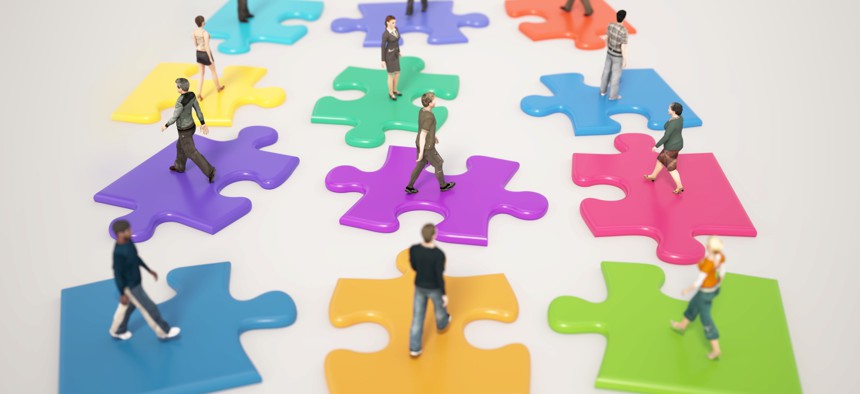
adventtr / Getty Images
Sharing services is essential for the federal government. Here’s how to make it work
COMMENTARY | Tackling the big problems facing federal agencies requires collaboration that goes beyond performance metrics to reach a solution.
Updated at 5:07 p.m. on Aug. 3, 2025
The inescapable reality of modern government is that no organization can control or fully manage any problem that really matters. Sharing services is the inescapable reality.
Scott Ruskan makes that point. Immediately after a river tsunami swept through the Texas Hill Country, Ruskan and the crew of a Coast Guard helicopter based in Corpus Christi, 200 miles away took off for Camp Mystic. Ruskan said that they encountered “some of the worse flying conditions we’ve been in.” They snagged five campers and then put Ruskan on the ground to coordinate the rescue of 200 more campers.
Saving lives in those awful days took the shared contributions of federal, state and local governments. In addition to the Coast Guard, help came from the federal government’s Customs and Border Protection, and FEMA, as well as state emergency rescue teams and the local first responders. The Department of Homeland Security pointed to “unprecedented action alongside Texas first responders for search and rescue operations.”
We’ve discovered, yet again, that sharing services lies at the core of so much of what government does. But this reminds me of a story that a wry senior official at the Office of Management and Budget once told me. He said that, toward the end of his time at OMB, someone came and whispered in his ear, “The answer to your problems is to collaborate!” He slapped his forehead and said, “Well, why didn’t I think of that??? !!!”
If this is such a great—and inescapable—idea, then why is it so hard?
A big answer, according to a pathbreaking University of Maryland study conducted in concert with the Shared Services Leadership Coalition, is that too often it’s too hard to develop performance metrics that point to “‘mission benefit’—how shared services contribute to agencies’ goals beyond efficiency.”
Too often, in addition, agencies can’t shift gears fast enough to focus on new problems—and “maintain long-term value and relevance.”
Solving these problems requires six “M” steps.
- Motivation. If it is such a great idea, then why aren’t we doing more of it? Like the conversation that the former OMB official had, the need for collaboration and sharing seems obvious—until someone tries to do it. The underlying problem is this: What is the question to which sharing and collaboration are the answers? And the question is this: How can we make sure we can line up the government’s capacity to the problems that need to be solved?
- Mismatch. The deeper problem is this: Too often, we take a vertical approach to an increasingly horizontal world. But, as I have previously written, there’s no problem that matters that any one organization can control. Our world is increasingly horizontal; vertical approaches, based on hierarchy, are bound to fail. This is a particular problem with many of the DOGE-based reforms. They’re all based on a hierarchical view of the world.
- Missing link. When we do focus on a program’s results, the keystone of sharing and collaboration, too often we do not align the program’s performance standards with the incentives for individual performance. Collaboration is always riskier than staying safely inside the hierarchical cocoon. Without incentives for effective collaborative problem solving, collaboration doesn’t work—and problems don’t get solved.
- Masses. Too often, the people that government tries to serve get lost in the hierarchical chair or the performance metrics. People have to come first in the quest for results.
- Muscle. We have a world where, inevitably, there are fewer governmental employees, more pressure on government workers and rising expectations about government problem solving. This doesn’t mean we need to hire lots more government workers, but we do need to make sure that we have the right muscle behind our public ambition: The right workers in the right places at the right times. This is the new face of strategic planning.
- Machine learning. It’s tempting to paint AI as either the grand salvation of all problems or the great evil sure to make them all worse. The reality is different: Information is the central nervous system of the increasingly horizontal world, and AI can provide the language for improving that system.
It’s tempting to conclude that all of this is very complex (which it is) to the point that it all requires new policies, regulations, executive orders and legislation (which it does not). In fact, it’s like the story of Dorothy in the Wizard of Oz.
Dorothy had a pretty rough time of it: A whirling encounter with a tornado, a challenge from a kindly witch to find the yellow brick road, a scary walk through woods and encounters with unusual creatures, a visit to a wizard who demands she bring back a wicked witch’s broomstick, all to help her get back home. It’s a charming story (although, truth be told, the flying monkeys still creep me out).
But one part of the story is the most important of all for our tale today. At the end of the movie, the Good Witch Glenda tells Dorothy, “You’ve always had the Power, my Dear. You just had to learn it for yourself.” Part of me is really annoyed for Dorothy—why did she have to go through all the nasty steps only to be told she had the power in her shoes to begin with?
Part of me, however, finds it heartening in this lesson for collaboration and sharing: We don’t need a mystical intervention. We have had the power all along—we just need to use it. The six “M’s” tell us how.
Correction: An earlier version of this report incorrectly identified the Shared Services Leadership Coalition as the Shared Services Association.







